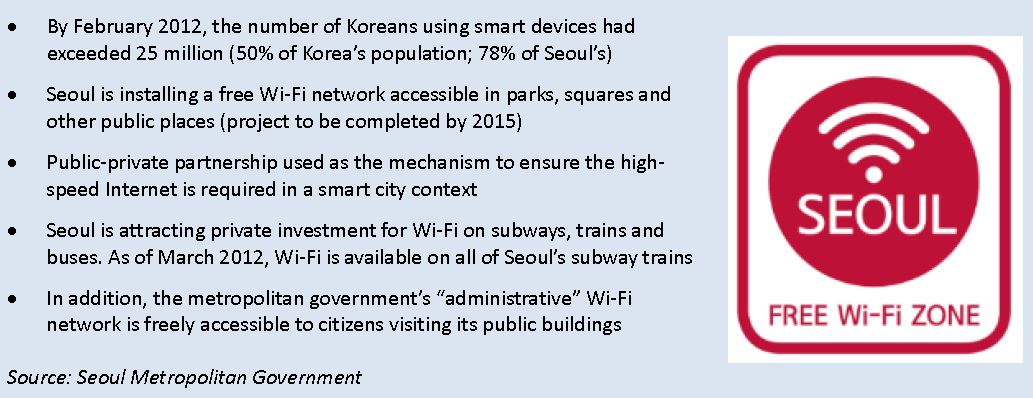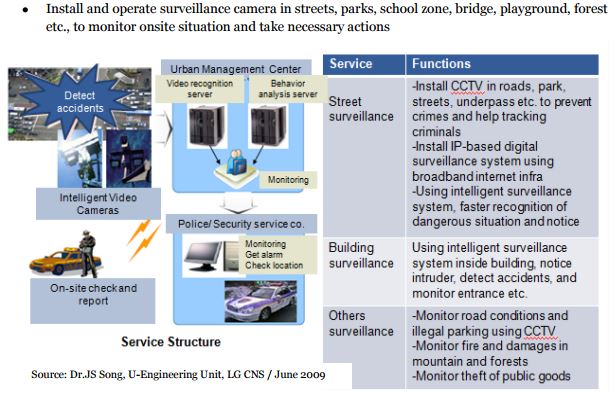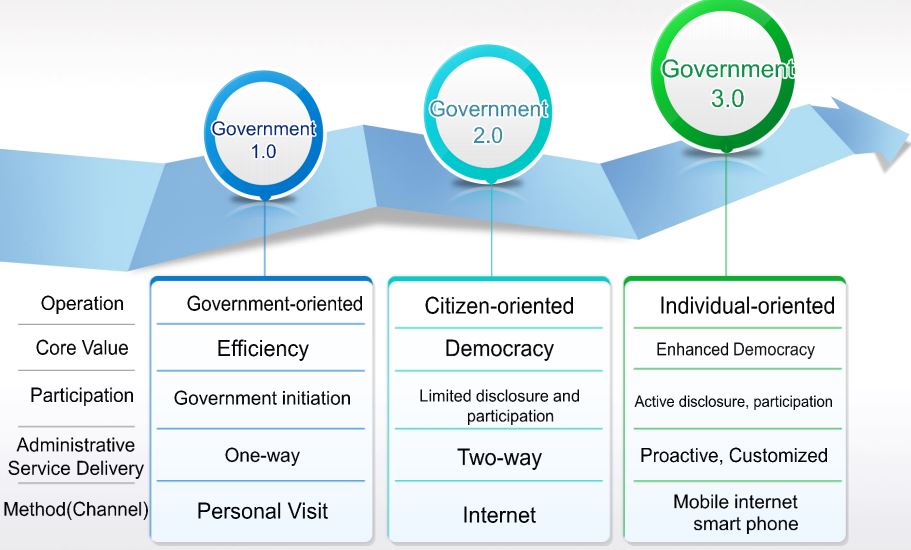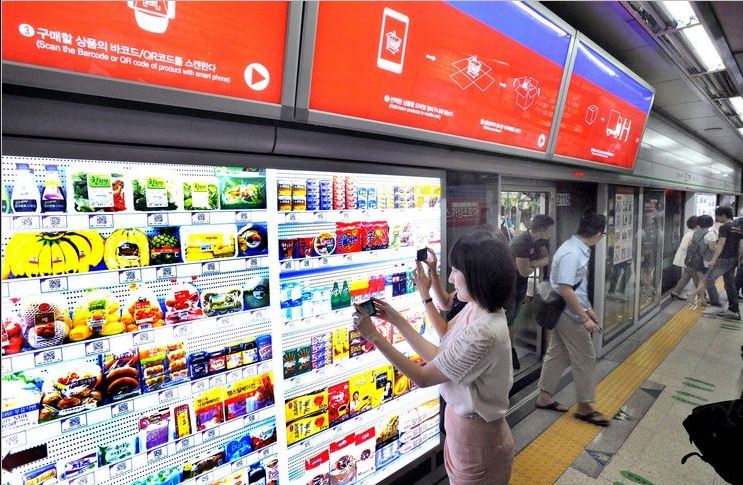[Innovation News] The Technologies Make Seoul the Smartest City in the World
The Technologies Make Seoul the Smartest City in the World
.JPG)
• The First Phase, or the individual service level, applies ICT to improve individual city operations such as transportation, safety, environment and culture. The majority of 2012’s smart city projects lie in this phase, an example being the addition of real-time bus schedule information to public transportation services, or using closed-circuit television (CCTV) to a greater extent in maintaining public safety.
• The Second Phase, or the vertical service level, integrates related processes and services by smart technology within major sectors of a city, enabling the provision of more advanced services. Taking the transportation sector as an example, citizens are offered information on the public transportation system’s real-time activity as well as emergencies, road conditions, road repairs and subsequent detours. Smart city services are not yet integrated across sectors, but people will experience leaps forward in the quality of service provided by each sector.
• The Third Phase, or the horizontal service level, is the point of smart city development at which there is no longer a distinction between different service areas, with all parts now seamlessly integrated within an efficient smart city ecosystem. The Second Phase, and especially the Third Phase, will see the creation of many new B2B (business-tobusiness) and B2C (business-to-customer) models making use of smart-city infrastructures to provide improved services
(Source: IUT(2013), https://www.itu.int/dms_pub/itu-t/oth/23/01/T23010000190001PDFE.pdf)

Roads that recharge: First ‘electric’ road charges buses in S Korea

.JPG)
OLEV (Online electric vehicle technology) enables vehicles to transfer electricity wirelessly from the road surface while they’re moving. As a bus drives through along one of the recharging surfaces, power comes from electrical cables buried under the surface of the road, creating magnetic fields. There is a receiving device installed on the underbody of the OLEV that converts these fields into electricity. The length of power strips installed under the road is generally 5%-15% of the entire road, requiring only a few sections of the road to be rebuilt with the embedded cables.
The strip of road lined with cables is also able to distinguish OLEV buses from regular vehicles, meaning it can switch itself off when it’s not in use. As the buses don’t need to hold enough charge for the entirety of their journeys, their batteries are around three times smaller than those on most electric vehicles.
For more about this technology, watch on this video: https://www.youtube.com/watch?v=FVRclpJbItM
U-Seoul Safety Service
U-Seoul Safety Service has been in operation since April 2008, combining location-based services and CCTV technologies to notify authorities and family members of emergencies involving children, the disabled, the elderly, and those suffering from Alzheimer’s disease, all of whom are voluntarily equipped with a smart device. When its holder leaves a designated safe zone or pushes its emergency button, an emergency alert is sent to guardians, police, fire departments and CCTV Control Centers.
Open Governance and Public Data
Seoul’s open governance strategy encourages transparent city governance and open communication between the city’s government and its citizens. Citizens and the private sector are consequently encouraged to make use of the city’s administrative information to uncover new job and business opportunities.
In March 2013, using GPS embedded in smartphones, the Seoul Metropolitan Government began to offer “Information around myself on maps,” a feature that provides information on locations of free Wi-Fi zones, disabled-friendly facilities, unmanned certification-issuing equipment, restrooms, and construction sites. There is also the Dasan Call Center, a 24/7 government agency that fields all questions regarding city services. Residents can also book public services and utilities through the internet 24/7.
Seoul Open Data Square 36 is a key building block to the Information Open Square. Opened in April 2012, the website discloses public information under ten categories: General administrative work; Welfare, culture and tourism; City management; Environment; Safety/security; Education; Health; Industry; Economy; and Transportation. Within these categories, 33 public information systems and 880 different datasets provide information on child-care services, public-transportation routes, bus arrival times, parking availability, weather conditions by region, and Seoul’s recommended restaurants; all accompanied by maps, internet links, graphs or statistics.
The Metropolitan Government plans to add another 150 public information systems to Open Data Square, initially aiming to increase the number of systems from 60 in 2012, to 100 in 2013. With the exception of citizens’ personal information, Seoul Open Data Square shares almost all information in its original form –giving citizens and businesses the raw data they need to develop apps enhancing the quality and efficiency of public services.
Eunpyeong u-City
Eun-pyeong is a district of Seoul, and Eun-pyeong u-City, a project beginning in 2006, was completed in March 2011 and now houses 45,000 people on land covering 3.49 million m2 (862.3 acres).
Eun-pyeong’s residents do not require private Internet access or smart devices to make use of city services, and instead receive practical information via smart devices on their living room walls. In the interests of residents’ safety, intelligent CCTV cameras installed on every street corner automatically detect people trespassing on private premises.
If a disabled or elderly person carrying a Location Detecting Device leaves Eun-pyeong or pushes an emergency bell on the device, their location is automatically sent to their guardians via text message. The city’s high-tech “Complex Street Lamps” reduce energy use, and also broadcast audio and provide residents with wireless internet access. The Media Board, which is set up in the New Town, is a digital newsletter providing news, the bus schedule and other practical information to residents and visitors. Finally, the city’s u-Green service represents a network of sensors assessing factors such as water and air quality, transmitting this information directly to the Media Board and the devices in citizen’s living rooms. The Seoul Metropolitan Government runs a u-City Consolidated Operation Center which oversees the web of ICTs composing Eun-pyeong u-City; managing its ubiquitous ICT networks, and collecting and archiving vital city information.
Virtual stores
Virtual Store is an example of B2B and B2C utilization of smart devices and social networks. Virtual Stores are found on street billboards, with each item possessing a unique barcode or Quick Response (QR) code. A smart phone’s barcode or QR code reader allows consumers to purchase goods
while on the move, receiving delivery at their homes later that day. The HomePlus Application facilitates transactions at HomePlus Virtual Stores. The application combines traditional and virtual shopping experiences, allowing customers to purchase goods using a smart-phone app able to read product barcodes or QR codes. With purchased items delivered to customers’ homes, citizens can shop for groceries and other goods without the inconvenience of carrying shopping bags.
HomePlus’ first Virtual Store opened in August 2011, and more were added to bus stops near universities in October that same year. 65 percent of these stores’ total sales were accounted for by customers in the 20 to 30 year-old age bracket, and 21 more virtual stores have thus been positioned in areas frequented by young people; at subway stations or bus stops in towns such as Deahak-ro, Shinchon and Gangnam.


